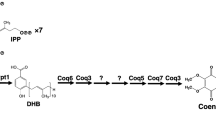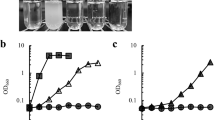Abstract
The budding yeast Saccharomyces cerevisiae is able to utilize glycerol as the sole carbon source via two pathways (glycerol 3-phosphate pathway and dihydroxyacetone [DHA] pathway). In contrast, the fission yeast Schizosaccharomyces pombe does not grow on media containing glycerol as the sole carbon source. However, in the presence of other carbon sources such as galactose and ethanol, S. pombe could assimilate glycerol and glycerol was preferentially utilized over ethanol and galactose. No equivalent of S. cerevisiae Gcy1/glycerol dehydrogenase has been identified in S. pombe. However, we identified a gene in S. pombe, SPAC13F5.03c (gld1 +), that is homologous to bacterial glycerol dehydrogenase. Deletion of gld1 caused a reduction in glycerol dehydrogenase activity and prevented glycerol assimilation. The gld1Δ cells grew on 50 mM DHA as the sole carbon source, indicating that the glycerol dehydrogenase encoded by gld1 + is essential for glycerol assimilation in S. pombe. Strains of S. pombe deleted for dak1 + and dak2 + encoding DHA kinases could not grow on glycerol and showed sensitivity to a higher concentration of DHA. The dak1Δ strain showed a more severe reduction of growth on glycerol and DHA than the dak2Δ strain because the expression of dak1 + mRNA was higher than that of dak2 +. In wild-type S. pombe, expression of the gld1 +, dak1 +, and dak2 + genes was repressed at a high concentration of glucose and was derepressed during glucose starvation. We found that gld1 + was regulated by glucose repression and that it was derepressed in scr1Δ and tup12Δ strains.






Similar content being viewed by others
References
Aguilera J, Randez-Gil F, Prieto JA (2007) Cold response in Saccharomyces cerevisiae: new functions for old mechanisms. FEMS Microbiol Rev 31:327–341
Albertyn J, Hohmann S, Thevelein JM, Prior BA (1994) GPD1, which encodes glycerol-3-phosphate dehydrogenase, is essential for growth under osmotic stress in Saccharomyces cerevisiae, and its expression is regulated by the high-osmolarity glycerol response pathway. Mol Cell Biol 14:4135–4144
Ansell R, Granath K, Hohmann S, Thevelein JM, Adler L (1997) The two isoenzymes for yeast NAD+-dependent glycerol 3-phosphate dehydrogenase encoded by GPD1 and GPD2 have distinct roles in osmoadaptation and redox regulation. EMBO J 16:2179–2187
Boy-Marcotte E, Lagniel G, Perrot M, Bussereau F, Boudsocq A, Jacquet M, Labarre J (1999) The heat shock response in yeast: differential regulations and contributions of the Msn2p/Msn4p and Hsf1p regulons. Mol Microbiol 33:274–283
Compagno C, Brambilla L, Capitanio D, Boschi F, Ranzi BM, Porro D (2001) Alterations of the glucose metabolism in a triose phosphate isomerase-negative Saccharomyces cerevisiae mutant. Yeast 18:663–670
de Vries RP, Flitter SJ, van de Vondervoort PJ, Chaveroche MK, Fontaine T, Fillinger S, Ruijter GJ, d'Enfert C, Visser J (2003) Glycerol dehydrogenase, encoded by gldB is essential for osmotolerance in Aspergillus nidulans. Mol Microbiol 49:131–141
Eriksson P, Andre L, Ansell R, Blomberg A, Adler L (1995) Cloning and characterization of GPD2, a second gene encoding sn-glycerol 3-phosphate dehydrogenase (NAD+) in Saccharomyces cerevisiae, and its comparison with GPD1. Mol Microbiol 17:95–107
Fagerstrom-Billai F, Wright AP (2005) Functional comparison of the Tup11 and Tup12 transcriptional corepressors in fission yeast. Mol Cell Biol 25:716–727
Fagerstrom-Billai F, Durand-Dubief M, Ekwall K, Wright AP (2007) Individual subunits of the Ssn6-Tup11/12 corepressor are selectively required for repression of different target genes. Mol Cell Biol 27:1069–1082
Ferreira C, van Voorst F, Martins A, Neves L, Oliveira R, Kielland-Brandt MC, Lucas C, Brandt A (2005) A member of the sugar transporter family, Stl1p is the glycerol/H+ symporter in Saccharomyces cerevisiae. Mol Biol Cell 16:2068–2076
Fujita Y, Giga-Hama Y, Takegawa K (2005) Development of a genetic transformation system using new selectable markers for fission yeast Schizosaccharomyces pombe. Yeast 22:193–202
Gancedo C, Llobell A, Ribas JC, Luchi F (1986) Isolation and characterization of mutants from Schyzosaccharomyces pombe defective in glycerol catabolism. Eur J Biochem 159:171–174
Gasch AP, Spellman PT, Kao CM, Carmel-Harel O, Eisen MB, Storz G, Botstein D, Brown PO (2000) Genomic expression programs in the response of yeast cells to environmental changes. Mol Biol Cell 11:4241–4257
Giga-Hama Y, Tohda H, Takegawa K, Kumagai H (2007) Schizosaccharomyces pombe minimum genome factory. Biotechnol Appl Biochem 46:147–155
Godon C, Lagniel G, Lee J, Buhler JM, Kieffer S, Perrot M, Boucherie H, Toledano MB, Labarre J (1998) The H2O2 stimulon in Saccharomyces cerevisiae. J Biol Chem 273:22480–22489
Grauslund M, Ronnow B (2000) Carbon source-dependent transcriptional regulation of the mitochondrial glycerol-3-phosphate dehydrogenase gene, GUT2, from Saccharomyces cerevisiae. Can J Microbiol 46:1096–1100
Grauslund M, Lopes JM, Ronnow B (1999) Expression of GUT1, which encodes glycerol kinase in Saccharomyces cerevisiae, is controlled by the positive regulators Adr1p, Ino2p and Ino4p and the negative regulator Opi1p in a carbon source-dependent fashion. Nucleic Acids Res 27:4391–4398
Greenall A, Hadcroft AP, Malakasi P, Jones N, Morgan BA, Hoffman CS, Whitehall SK (2002) Role of fission yeast Tup1-like repressors and Prr1 transcription factor in response to salt stress. Mol Biol Cell 13:2977–2989
Hirota K, Hoffman CS, Ohta K (2006) Reciprocal nuclear shuttling of two antagonizing Zn finger proteins modulates Tup family corepressor function to repress chromatin remodeling. Eukaryot Cell 5:1980–1989
Hohmann S, Krantz M, Nordlander B (2007) Yeast osmoregulation. Methods Enzymol 428:29–45
Huang M, Zhou Z, Elledge SJ (1998) The DNA replication and damage checkpoint pathways induce transcription by inhibition of the Crt1 repressor. Cell 94:595–605
Iwaki T, Takegawa K (2004) A set of loxP marker cassettes for Cre-mediated multiple gene disruption in Schizosaccharomyces pombe. Biosci Biotechnol Biochem 68:545–550
Jelinsky SA, Samson LD (1999) Global response of Saccharomyces cerevisiae to an alkylating agent. Proc Natl Acad Sci U S A 96:1486–1491
Keleher CA, Redd MJ, Schultz J, Carlson M, Johnson AD (1992) Ssn6-Tup1 is a general repressor of transcription in yeast. Cell 68:709–719
Kim ST, Huh WK, Lee BH, Kang SO (1998) D-arabinose dehydrogenase and its gene from Saccharomyces cerevisiae. Biochim Biophys Acta 1429:29–39
Kimura T, Takahashi M, Yoshihara K, Furuichi T, Suzuki K, Imai K, Karita S, Sakka K, Ohmiya K (1998) Cloning and characterization of two genes encoding dihydroxyacetone kinase from Schizosaccharomyces pombe IFO 0354. Biochim Biophys Acta 1442:361–368
Komachi K, Johnson AD (1997) Residues in the WD repeats of Tup1 required for interaction with alpha2. Mol Cell Biol 17:6023–6028
Kuhn A, van Zyl C, van Tonder A, Prior BA (1995) Purification and partial characterization of an aldo-keto reductase from Saccharomyces cerevisiae. Appl Environ Microbiol 61:1580–1585
Lages F, Silva-Graca M, Lucas C (1999) Active glycerol uptake is a mechanism underlying halotolerance in yeast: a study of 42 species. Microbiology 145:2577–2585
Molin M, Blomberg A (2006) Dihydroxyacetone detoxification in Saccharomyces cerevisiae involves formaldehyde dissimilation. Mol Microbiol 60:925–938
Molin M, Norbeck J, Blomberg A (2003) Dihydroxyacetone kinases in Saccharomyces cerevisiae are involved in detoxification of dihydroxyacetone. J Biol Chem 278:1415–1423
Molin M, Pilon M, Blomberg A (2007) Dihydroxyacetone-induced death is accompanied by advanced glycation endproduct formation in selected proteins of Saccharomyces cerevisiae and Caenorhabditis elegans. Proteomics 7:3764–3774
Moreno S, Klar A, Nurse P (1991) Molecular genetic analysis of fission yeast Schizosaccharomyces pombe. Methods Enzymol 194:795–823
Morita T, Takegawa K (2004) A simple and efficient procedure for transformation of Schizosaccharomyces pombe. Yeast 21:613–617
Mukai Y, Matsuo E, Roth SY, Harashima S (1999) Conservation of histone binding and transcriptional repressor functions in a Schizosaccharomyces pombe Tup1p homolog. Mol Cell Biol 19:8461–8468
Nakamura K, Kondo S, Kawai Y, Nakajima N, Ohno A (1997) Amino acid sequence and characterization of aldo-keto reductase from bakers' yeast. Biosci Biotechnol Biochem 61:375–377
Neely LA, Hoffman CS (2000) Protein kinase A and mitogen-activated protein kinase pathways antagonistically regulate fission yeast fbp1 transcription by employing different modes of action at two upstream activation sites. Mol Cell Biol 20:6426–6434
Norbeck J, Blomberg A (1997) Metabolic and regulatory changes associated with growth of Saccharomyces cerevisiae in 1.4 M NaCl. Evidence for osmotic induction of glycerol dissimilation via the dihydroxyacetone pathway. J Biol Chem 272:5544–5554
Norbeck J, Pahlman AK, Akhtar N, Blomberg A, Adler L (1996) Purification and characterization of two isoenzymes of DL-glycerol-3-phosphatase from Saccharomyces cerevisiae. Identification of the corresponding GPP1 and GPP2 genes and evidence for osmotic regulation of Gpp2p expression by the osmosensing mitogen-activated protein kinase signal transduction pathway. J Biol Chem 271:13875–13881
Oechsner U, Magdolen V, Bandlow W (1988) A nuclear yeast gene (GCY) encodes a polypeptide with high homology to a vertebrate eye lens protein. FEBS Lett 238:123–128
Okazaki K, Okazaki N, Kume K, Jinno S, Tanaka K, Okayama H (1990) High-frequency transformation method and library transducing vectors for cloning mammalian cDNAs by trans-complementation of Schizosaccharomyces pombe. Nucleic Acids Res 18:6485–6489
Pavlik P, Simon M, Schuster T, Ruis H (1993) The glycerol kinase (GUT1) gene of Saccharomyces cerevisiae: cloning and characterization. Curr Genet 24:21–25
Pelletier B, Beaudoin J, Mukai Y, Labbe S (2002) Fep1, an iron sensor regulating iron transporter gene expression in Schizosaccharomyces pombe. J Biol Chem 277:22950–22958
Proft M, Struhl K (2002) Hog1 kinase converts the Sko1-Cyc8-Tup1 repressor complex into an activator that recruits SAGA and SWI/SNF in response to osmotic stress. Mol Cell 9:1307–1317
Proft M, Pascual-Ahuir A, de Nadal E, Arino J, Serrano R, Posas F (2001) Regulation of the Sko1 transcriptional repressor by the Hog1 MAP kinase in response to osmotic stress. EMBO J 20:1123–1133
Rep M, Krantz M, Thevelein JM, Hohmann S (2000) The transcriptional response of Saccharomyces cerevisiae to osmotic shock. Hot1p and Msn2p/Msn4p are required for the induction of subsets of high osmolarity glycerol pathway-dependent genes. J Biol Chem 275:8290–8300
Ronnow B, Kielland-Brandt MC (1993) GUT2, a gene for mitochondrial glycerol 3-phosphate dehydrogenase of Saccharomyces cerevisiae. Yeast 9:1121–1130
Smith RL, Johnson AD (2000) Turning genes off by Ssn6-Tup1: a conserved system of transcriptional repression in eukaryotes. Trends Biochem Sci 25:325–330
Sambrook J, Fritsch E, Maniatis T (1989) Molecular cloning: a laboratory manual, 2nd edn. Cold Spring Harbor Laboratory Press, Cold Spring Harbor
Spencer P, Bown KJ, Scawen MD, Atkinson T, Gore MG (1989) Isolation and characterisation of the glycerol dehydrogenase from Bacillus stearothermophilus. Biochim Biophys Acta 994:270–279
Suga M, Hatakeyama T (2001) High efficiency transformation of Schizosaccharomyces pombe pretreated with thiol compounds by electroporation. Yeast 18:1015–1021
Suga M, Isobe M, Hatakeyama T (2000) Cryopreservation of competent intact yeast cells for efficient electroporation. Yeast 16:889–896
Takegawa K, Tohda H, Sasaki M, Idiris A, Ohashi T, Mukaiyama H, Giga-Hama Y, Kumagai H (2009) Production of heterologous proteins using the fission-yeast (Schizosaccharomyces pombe) expression system. Biotechnol Appl Biochem 53:227–235
Tanaka N, Ohuchi N, Mukai Y, Osaka Y, Ohtani Y, Tabuchi M, Bhuiyan MS, Fukui H, Harashima S, Takegawa K (1998) Isolation and characterization of an invertase and its repressor genes from Schizosaccharomyces pombe. Biochem Biophys Res Commun 245:246–253
Thompson JC, He BB (2006) Characterization of crude glycerol from biodiesel production from multiple feedstocks. Appl Eng Agric 22:261–265
Treitel MA, Carlson M (1995) Repression by SSN6-TUP1 is directed by MIG1, a repressor/activator protein. Proc Natl Acad Sci U S A 92:3132–3136
Vido K, Spector D, Lagniel G, Lopez S, Toledano MB, Labarre J (2001) A proteome analysis of the cadmium response in Saccharomyces cerevisiae. J Biol Chem 276:8469–8474
Znaidi S, Pelletier B, Mukai Y, Labbe S (2004) The Schizosaccharomyces pombe corepressor Tup11 interacts with the iron-responsive transcription factor Fep1. J Biol Chem 279:9462–9474
Acknowledgments
We thank Dr. Yukio Mukai for the fission yeast strains. This work was partly supported by the Project for Development of a Technological Infrastructure for Industrial Bioprocesses on R&D of New Industrial Science and Technology Frontiers by the Ministry of Economy, Trade & Industry (METI), as supported by the New Energy and Industrial Technology Development Organization (NEDO).
Author information
Authors and Affiliations
Corresponding author
Rights and permissions
About this article
Cite this article
Matsuzawa, T., Ohashi, T., Hosomi, A. et al. The gld1 + gene encoding glycerol dehydrogenase is required for glycerol metabolism in Schizosaccharomyces pombe . Appl Microbiol Biotechnol 87, 715–727 (2010). https://doi.org/10.1007/s00253-010-2586-3
Received:
Revised:
Accepted:
Published:
Issue Date:
DOI: https://doi.org/10.1007/s00253-010-2586-3




